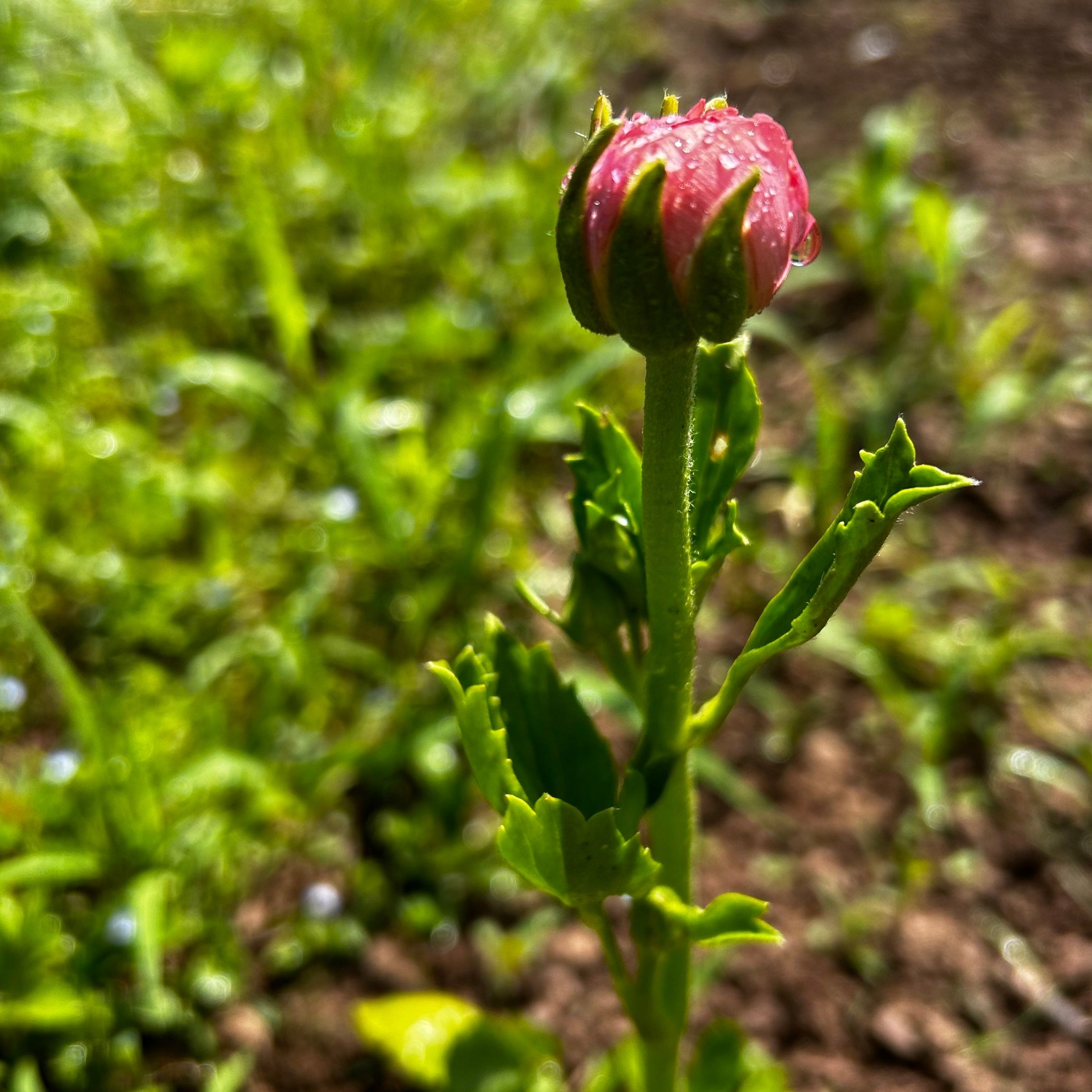Ranunculus, Anemones, and the Delicate Art of Not Crying in the Basement
This spring marks my second year growing ranunculus and my first year growing anemones, which is a very kind and professional way of saying I am once again throwing money and emotional investment into corms with an uncertain outcome. It’s not technically gambling, but if someone ever wanted to make a flower farmer scratch-off ticket, it would just be trays of pre-sprouted ranunculus and a deer lurking behind every shiny scratcher space.
Last year, I had one single ranunculus bloom. It was a beautiful hot pink—glorious, defiant, and fleeting. A real underdog story. And then a deer ate it. While I was at work. Before I could cut it. The wound is still fresh. I talk about it more than I talk about my traumatic early adulthood.
This year, I decided to give it another go because I enjoy suffering and also because I apparently have the sort of eternal, misplaced optimism that only flower farmers and people assembling IKEA furniture for the third time truly understand. (We listen and we don’t judge. I love putting together IKEA furniture. And I have passed this genetic marker along to my oldest son.)
The Basement Laboratory (a.k.a. Where Hope Goes to Mold)
I presprouted both ranunculus and anemones in my basement this year. I used a fancy AI tool to time my process according to my zone (6B), because if I’m going to fail, I’d at least like to fail on schedule that I could never establish on my own. I followed all the steps: soaked the corms, gave them a cozy bed of moist potting mix, set them in a dark corner, whispered affirmations.
And then, of course, I rotted some of them. Not all, just enough to knock my confidence back down to its normal baseline of “not quite sure what I’m doing, but too stubborn to stop.”
The anemones were new this year—ordered from Sunny Meadows Flower Farm—and I was really excited to try them. One of them actually sprouted and survived long enough to be planted. One. I’m not saying it’s the chosen one, but if it doesn’t bloom, I may need to burn sage over the flower beds. Despite the failure to launch, I held a garden burial for the remaining (thou shalt not tell how many I purchased…) corms. You just NEVER know. Perhaps the outdoor soil, worms and weeds are their chosen revival grounds.
Planting Time and PTSD (Post-Traumatic Sprout Disorder)
Getting them in the ground felt equal parts thrilling and wildly stressful. And cold. So darn cold. Why, Pennsylvania?! If you’ve never gently tucked a $40 tray of corms into a cold spring bed while muttering “please surprise me” then you haven’t truly lived.
Such surprises often happen in the garden. Like late this winter when I realized—some of my ranunculus came back. Like... after winter. Without protection. In Pennsylvania. It shouldn’t have happened. Every article I’ve read says they are not hardy here, and yet, there they were. Leaves. Stems. Actual signs of life. It's a flower miracle, or climate change. Honestly, hard to say. Getting run over by John Deere tractor tires at the hands of some young family drivers and still rallying has to be a minor miracle.
The ones from last year that survived are growing well, and the new ones (at least the ones that didn’t melt into goo in the basement) are doing better than I expected. And I’m daring to hope. Again. Because flower farming is just seasonal Stockholm syndrome. (Also arguably an extension of symptoms of a career in education.)
When the Deer Returns (Spoiler: They Always Return)
Now, I know I shouldn’t get too attached. Last year, I made the fatal mistake of falling in love and feeling immense pride in my one bloom and imagining what it might look like in a bouquet. I pictured it sitting in a mason jar at the stand, surrounded by a symphony of other stems I also didn't manage to grow.
And then, while I was molding young minds in my 7th grade classroom, a deer strolled by and snacked on that hot pink ranunculus like it was a $30 charcuterie board. It didn’t even have the decency to eat the whole thing. Just enough to make a point.
I haven’t seen any deer yet this spring, (just their hoof prints & my chomped down tulips) but I also haven’t installed any netting or fencing or deterrents. I am choosing instead to rely on magical thinking and the idea that maybe this time, the universe will be kind. (Stay tuned for Operation Electric Fence. Buzz Buzz, Bambi!)
Things I’ve Learned (Besides the High Cost of Hope)
Presprouting works, until it doesn’t.
The basement is both a blessing and a fungal breeding ground.
Anemones are dramatic and mysterious.
Ranunculus might be sneakily hardy or possibly possessed.
I am still bad at pest prevention.
Despite all of this, I love these flowers and will absolutely try again next year.
Closing Thoughts From the Middle of the Bloomless Bed
I don’t have a single ranunculus bloom yet this year. But I have plants. Leaves. Progress. And maybe even a little faith that something magical is going to happen out there while I’m not looking.
Even if nothing blooms, I’ll count it as a win. Because I didn’t give up. I tried again. I replanted the dream, even if it came back soggy.
And if a deer eats them again this year? Well, at least I’ll get another blog post out of it.


